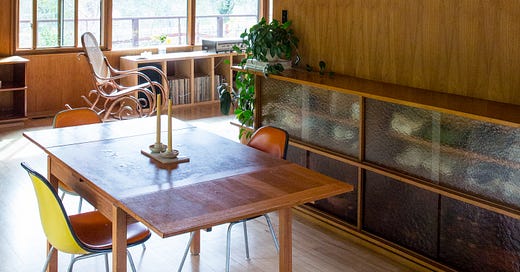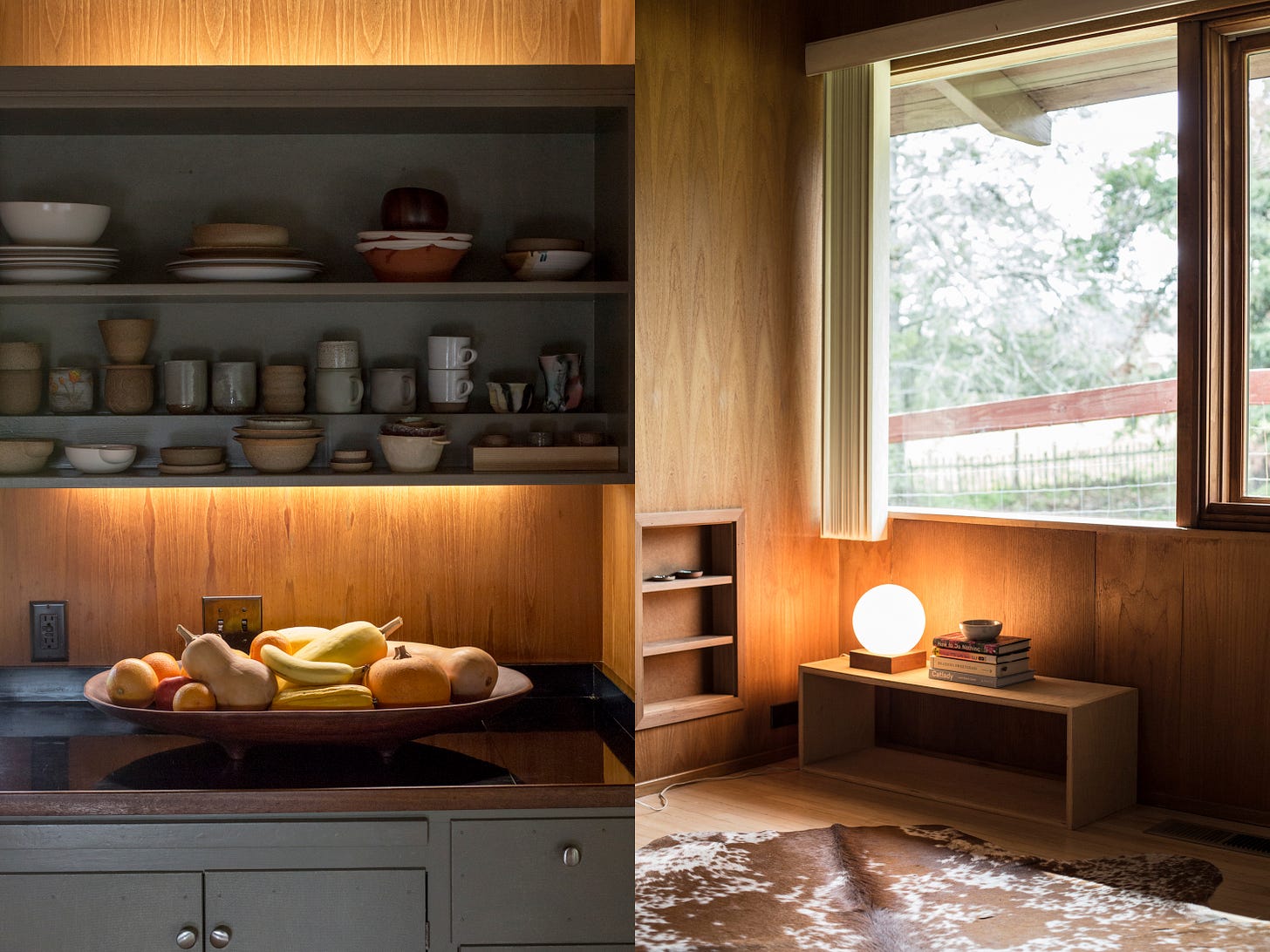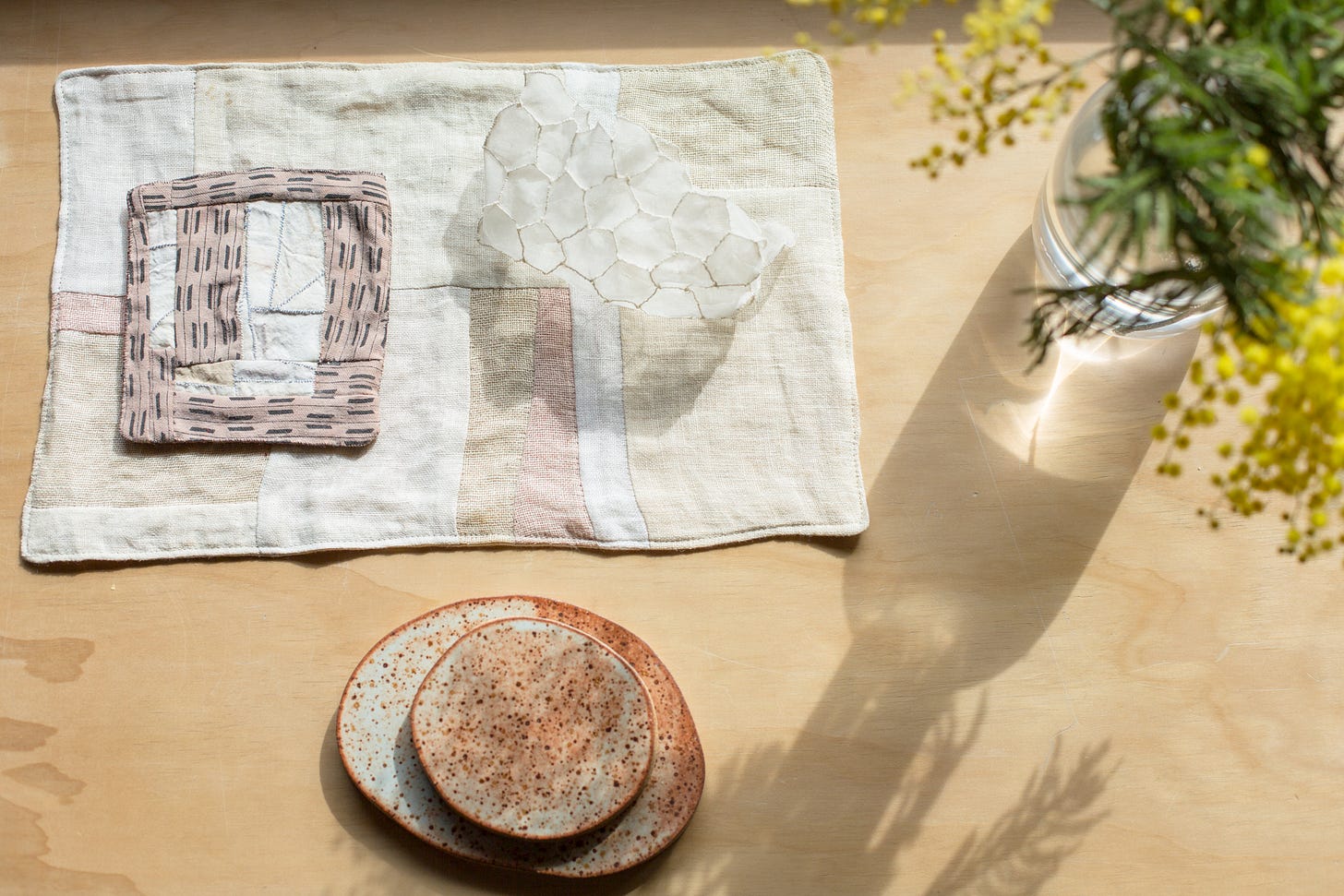At home in Sonoma, California with Julie Cloutier
"I take my time—months or sometimes years, to find the right thing." - Julie Cloutier
Good morning.
For the May issue of REALM I visited the cozy, tucked away, rural home of the artist and ceramicist Julie Cloutier in Sonoma, California. Hawks, lizards, deer and raccoons scattered in the sky and road as I approached. Julie shares her home, a quintessential Mid-century space, with her husband Matt Shapiro, a forager and chef. Theirs may be the most analog home I’ve photographed: within its absence of screens, mechanical whirring, and automation, slower pursuits are yielded to. There are nooks for painting, reading, playing instruments and tending to plants; for cooking and planting; for planning and making. Little goes wasted in Julie’s realm. Rather than rushing to bring anything not fully considered into her space, Julie waits for things resonant with her ethos of intentionality, quality, and understatement. Like her ceramics and paintings, Julie’s home has very conscious lines, gestures and color which work together through spareness and restraint.
The architecture is straightforward; a perfectly symmetrical square. The surrounding deck imparts a kind of temple garden tone, and exploring her space, in the right mindset, is a meditation. Within the house, the most social spaces—kitchen, dining and living room—are entered into first, while the generally more private spaces—bedroom and bathroom—are discovered only after passing through the rest of the house. A Mondrian-like, luminescent screen separates the private from the social realm, letting in the light, but not the gaze.
I was happily surprised by the last, innermost room: a white-walled bathroom bursting with natural light cast by a large skylight—a sharp contrast to the naturally darker wood walls of the rest of the house. Smartly, the natural light in that inner chamber of the house is redirected through frosted glass into the rest of the rooms (you’ll see these bright panels on the top right of the first photograph, below). An ingenious use of 1000 square feet, ideal for two, with zero wasted space, Julie and Matt’s home is a sort of time-capsule—as historical as it is fresh. Can I have the blueprints, please?
Enjoy.
Hi Julie! What is your home-aesthetic in 3 phrases?
Warm yet practical; minimal yet playful; intentional but ever-changing.
When you saw your current home for the first time, what was most inspiring and made you know it was right for you?
After being here just a few minutes, we knew this house couldn’t be more perfect for us. Although it was built more than fifty years ago, the size, proportion and built-ins suited our needs to a tee. It’s a small one bedroom-one bathroom, but it feels so spacious. Being surrounded by trees adds to the expansive nature of the place. The redwood ceiling, the square floor plan and symmetrical windows make my architecture-brain sing.
How would you describe the architectural style of your home?
Our home was built in 1963 and it’s of the mid-century modern style with all of the Northern California vibes—a focus on simplicity, and a mix of local materials and off-the-shelf products. It was designed and built by a local architect, Lee Beach, as a case study for further development, but the intention never panned out so this is the only one.
Tell me about your most beloved possession. How did it enter your life, and how does it affect you on a regular basis?
I have to say, I do not have any one item that I feel super connected to. As a child, I moved around a lot and always enjoyed not having much stuff. All of our furniture is either purchased used from flea markets, Craigslist, estate sales or found off the street, so there is no heirloom quality to our possessions. However, I love what we’ve surrounded ourselves with and that we’ve given them a second life.
Each piece is linked to a memory and that’s important to me. Our kitchen table was purchased used at a consignment shop. At the time we lived in the city and did not have a car, so we walked the table about eight blocks to our apartment via the sidewalk. Our first couch couldn’t get through the door of a new apartment so after several months without one, I found our current Le Corbusier leather repro on Craigslist for a low price. When I went to go pick it up, it was at a dental office; a waiting room sofa. I love that. One cushion is much firmer than the other two—we’ve been working on trying to break it in for many years.
Are any of your life philosophies manifested within your home?
I consider myself a minimalist but more for practical reasons than visual aesthetic. Living with less, and with intention, enhances my well being, highlights objects that bring me joy and creates room for change and growth within the space.
What is your favorite aspect of your home, and why?
There are beautiful details to this house like the redwood ceiling and maple flooring reclaimed from a local high school gymnasium, but what truly speaks to me is its symmetry. The floor plan is a square, 32’ x 32’ with 16’ length of windows on all four sides. The interior core (8’x8’) holds the bathroom and a skylight which then projects into the interior. There are no hallways, therefore no wasted space. I feel incredibly lucky to live in this special little home.
I love those re-purposed gymnasium floors in a domestic setting they are ultra pale and narrow, and familiar, from childhood. What’s your relationship to waste at home, here?
Living in California, we are especially aware of our natural resources with constant drought conditions and wildfires. Our water comes from a hole in the ground: our well is thirty feet deep and taps into the aquifer below (I like to think of it as an underground river). We are conservative with our water usage. Our septic system can’t handle the laundry rinses, so we have a gray water system where you see the water discharge into the gravel driveway. Living in a rural environment reveals all the utilities that would typically be hidden in the city so I’m grateful to be aware of our consumption and see the resource. Not seeing the actual resource can put blinders on people.
How do you determine what possessions make the minimalist cut?
If something is purchased for our home, it’s out of necessity. But I take my time—months or sometimes years, to find the right thing. I never rush when making furniture decisions because I plan on having it for a very long time. I dwell, I overthink, I research. With art, I’m a bit looser and like to have fun and be whimsical with placement. I constantly move pieces around. We have a fair amount of paintings, drawings and sculptures but I get overwhelmed by all of it at once, so tend to have only a handful of pieces out at a time.
What would you like homes of the future to be like?
I wish all homes were built to last a lifetime. Good design and smart materials age well. If you look at the statistics, residential construction and demolition is extremely high and incredibly wasteful. I wish tear-downs didn’t exist. Too many people purchase a home with the intention of doing a huge remodel right from the get-go. I say live with the space for many years before updating and purchasing “new”.
What is the first thing you consider when you set up a space for living?
Function and location of natural light.
You have such a lovely eye for simplicity and space. How would you recommend others enhance their experience of a place they live in but don’t love?
Learn to love existing conditions and live with the space before judging. Every apartment and rental I lived in always had unique features that at first might not have been “my style” but I always learned to enjoy the peculiarities of each place and celebrate the oddities.
Do you have any daily habits intrinsically tied up with where you live?
I check in on our plants and fruit trees daily. I observe their progress and have learned so much from the plants, insects and animals. I’ve always considered myself observant but after living in rural Sonoma County, I’ve become more in tune with the local ecosystem and micro environments. It helps me slow down and appreciate the small things.
What’s the slowest thing you do at home?
Tea and breakfast are slow affairs. I really take my time every single morning. Since I’m self-employed and work out of my garage, I can take it as leisurely as I want and I cherish that time. Depending on the seasons, those mornings are spent on the deck or in different spots in the house where the light is best.
Describe your home in 5 words.
Warm, simple, efficient, playful and geometric.
Describe your dream home in 5 words.
Warm, simple, efficient, playful and geometric.
Delving Deeper:
Find out more about Cloutier Ceramics, Julie’s line of functional vessels and handheld sculptures. My favorite creations of Julie’s are double bowls which hold fruits and their pits side by side in an overlapping infinity loop. I’ve been eating dinner out of her shallow, broad bowls lately and they give meals expanded significance with their handsomeness and heft. Julie also co-designs one-of-a-kind lamps with the artist and electrician Rico Duenas. They’re hard to come by but worth the wait. Julie also teaches virtual painting classes with Case For Making each month if you are looking for a meditative morning mapping out shapes, lines and colors with her gentle guidance.
Consider home
…a place of deliberate detail and spatial balance, a place that earns its temperament slowly, by honing things patiently and precisely rather than impulsively or instantaneously. Julie has a way of making space for space itself in her home. This is true in her choice of rotating art on the walls, showing just a piece or two at a time, and in her particular, ever-shifting combinations of objects arranged on tabletops like still lives. Each arrangement is decisive and thoughtful. I palpably felt a physical sense of well-being and calm in Julie’s domestic realm and appreciated the cozy cocoon of steadiness, calm and intentionality it provided. Its darker, rather than bright white space, inspired me to reread Jun’ichiro Tanizaki’s essay on the Japanese sense of beauty, In Praise of Shadows. For anyone curious about traditional Japanese aesthetics in domestic spaces, it’s a lean and fun read.
This month’s recommendations have to do with listening and slowing down to pay attention to architecture, birds, and the poetics of space.
Excerpts of the poem-like list, Two Hundred and Fifty Things an Architect Should Know, by Michael Sorkin, is read aloud by Roman Mars in this recent episode of 99% Invisible: The Smell of Concrete After Rain. All about focused observation, undying curiosity and looking at things all over again, fresh-eyed, without assumption.
Jenny O’dell’s book How To Do Nothing is a recommendation from Julie. I’m reading it now and just want to point out it’s not so much about doing nothing as it is about paying attention to everything. It’s also very dense so if you are simply curious and want an abbreviated introduction to her ideas, O’dell offers a lovely conversation on this episode of the podcast For The Wild.
Lastly, I felt so calm listening to architect Billie Tsien speaking about Imbuing Buildings with Feelings on the podcast Time Sensitive. Her approach is profoundly resonant with Julie’s sensibility and I think it’s full of beauty and intelligence. I love anthropomorphizing objects, architecture and nature in order to better understand it: not everyone is into this but it’s ancient, animistic, and tapping into it is an energetic shift that has only ever made me feel more delight, humor and empathy for the world around me.
Etymology Interlude:
Intention in·ten·tion (noun). An aim, or plan.
12th Century. Old French, from Latin origin.
Entencion meaning "intent, purpose, aspiration; will; thought" derives from Latin intentionem meaning "a stretching out, straining, exertion, effort, or attention."
The root word is the noun intendere meaning "to turn one's attention." To have intention is not just an intellectual process, wherein the mind is fixed upon something—it is a process with a physical component—right there in its etymological origin: to stretch, to strain, or to lean toward.
What do you stretch and strain toward in the spaces you live? What do you turn your attention toward when machines are unplugged, when your devices are off? What is occupying the bulk of your attention in your home? Is it intellectual, physical, survivalist, spiritual, conversational, edible, aesthetic or practical?
Remember, intention is like a muscle—exercise it, and it can carry you places.
Until next time,
Airyka















